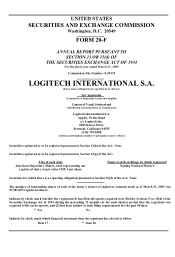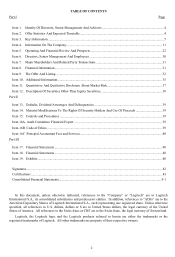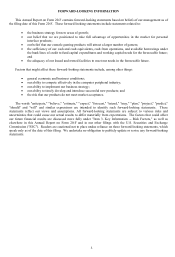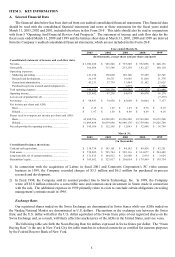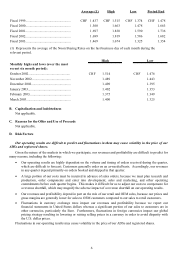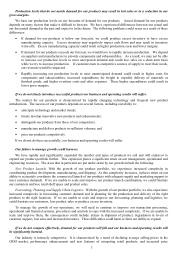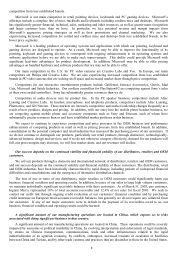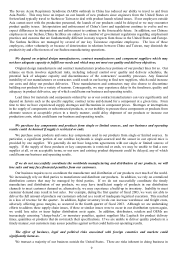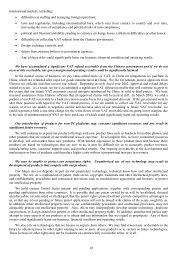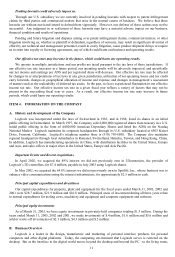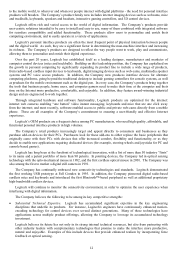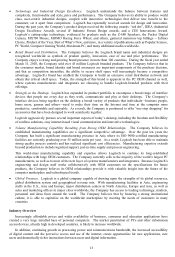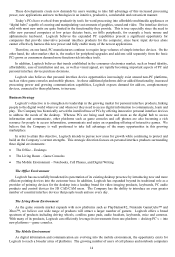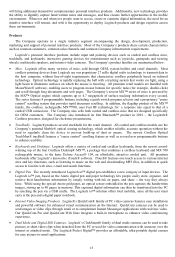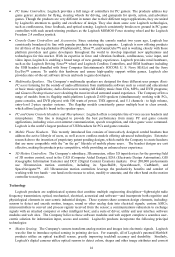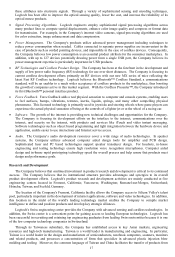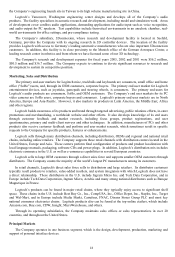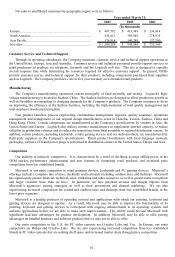Logitech 2003 Annual Report Download - page 22
Download and view the complete annual report
Please find page 22 of the 2003 Logitech annual report below. You can navigate through the pages in the report by either clicking on the pages listed below, or by using the keyword search tool below to find specific information within the annual report. 9
The Severe Acute Respiratory Syndrome (SARS) outbreak in China has reduced our ability to travel to and from
Asia-Pacific. This may have an impact on our launch of new products since engineers from the United States or
Switzerland typically travel to Suzhou or Taiwan to deal with product launch related issues. If our employees outside
Asia cannot meet with the production personnel, the launch of our products could be delayed or we may encounter
product quality issues. Interpretation and enforcement of China’s laws and regulations continue to evolve and we
expect differences in interpretation and enforcement to continue in the foreseeable future. In addition, our Chinese
employees in our Suzhou, China facilities are subject to a number of government regulations regarding employment
practices and customs that are fundamentally different in many respects from those in the United States and Europe.
The Suzhou facilities are managed by several of our key Taiwanese expatriate employees. The loss of these
employees, either voluntarily or because of deterioration in relations between China and Taiwan, may diminish the
productivity and effectiveness of our Suzhou manufacturing operations.
We depend on original design manufacturers, contract manufacturers and component suppliers which may
not have adequate capacity to fulfill our needs and which may not meet our quality and delivery objectives.
Original design manufacturers and contract manufacturers produce key portions of our product lines for us. Our
reliance on them involves significant risks, including reduced control over quality and delivery schedules, the
potential lack of adequate capacity and discontinuance of the contractors’ assembly processes. Any financial
instability of our manufacturers or contractors could result in our having to find new suppliers, which could increase
our costs and delay our product deliveries. These manufacturers and contractors may also choose to discontinue
building our products for a variety of reasons. Consequently, we may experience delay in the timeliness, quality and
adequacy in product deliveries, any of which could harm our business and operating results.
Lead times for materials and components ordered by us or our contract manufacturers can vary significantly and
depend on factors such as the specific supplier, contract terms and demand for a component at a given time. From
time to time we have experienced supply shortages and fluctuations in component prices. Shortages or interruptions
in the supply of components or subcontracted products, or our inability to procure these components or products from
alternate sources at acceptable prices in a timely manner, could delay shipment of our products or increase our
production costs, which could harm our business and operating results.
We purchase key components and products from single or limited sources, and our business and operating
results could be harmed if supply is restricted or ends.
We purchase some products and some key components used in our products from single or limited sources. In
particular, a significant portion of our cordless keyboards is single-sourced and the sensor in our optical mice is
provided by one supplier. We generally do not have long-term agreements with our single or limited sources of
supply. If the supply of these products or key components is restricted or ends, we may be unable to find a new
supplier at all, or on acceptable terms, or our new and existing product shipments could be delayed, any of which
could harm our business and operating results.
If we do not successfully coordinate the worldwide manufacturing and distribution of our products, we will
lose sales and may face financial penalties from our customers.
Our business requires us to coordinate the manufacture and distribution of our products over much of the world.
We increasingly rely on third parties to manufacture and distribute our products. In addition, we rely on centralized
distribution centers that may be managed by third parties. If we do not successfully coordinate the timely
manufacture and distribution of our products, we may have insufficient supply of products in our distribution
channels to meet customer demand or, alternatively, we may experience a build-up in inventory. Inability to meet
customer demand may result in lost sales. For example, during the first quarter of fiscal 2003, we were not able to
deliver the full amount of products our customers ordered as a result of inadequate logistical execution. This resulted
in a loss of revenue for the quarter. In addition, higher inventory levels can increase warehouse and freight costs,
adversely affecting gross margins, as occurred in the fourth quarter of fiscal 2003. Although we are undertaking
efforts to address these supply chain issues, if these or similar issues were to occur in our distribution system again,
we could lose sales or incur higher distribution costs again. In addition, distributors, retailers and OEMs are
increasingly assessing “charge-backs”, or monetary penalties, against suppliers like Logitech for product delivery
times, quantities or products that do not match their specifications. If we are unable to deliver quality products in a
timely manner, our customers may assess penalties against us that could harm our operating results.
The effect of business, legal and political risks associated with foreign countries and markets could
significantly harm us.
We transact a majority of our business outside the United States. There are risks inherent in doing business in




